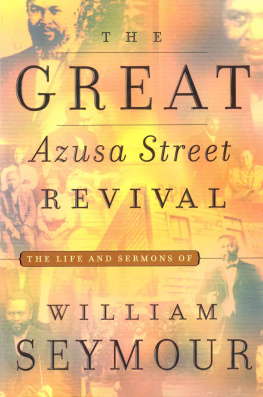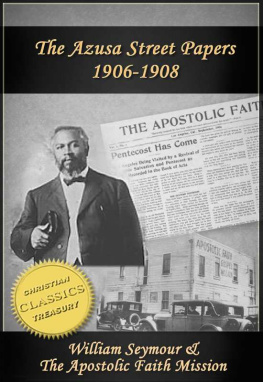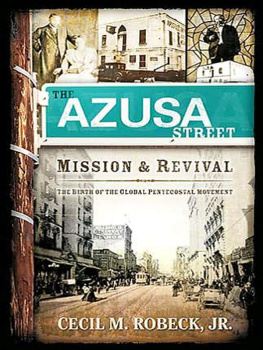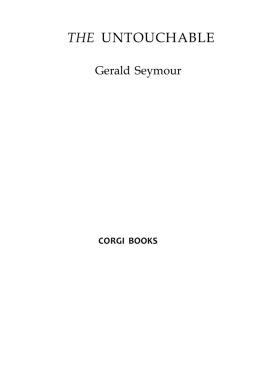William Seymour - The Great Azusa Street Revival: The Life and Sermons of William Seymour
Here you can read online William Seymour - The Great Azusa Street Revival: The Life and Sermons of William Seymour full text of the book (entire story) in english for free. Download pdf and epub, get meaning, cover and reviews about this ebook. year: 2014, publisher: Embassy Publishing, genre: Religion. Description of the work, (preface) as well as reviews are available. Best literature library LitArk.com created for fans of good reading and offers a wide selection of genres:
Romance novel
Science fiction
Adventure
Detective
Science
History
Home and family
Prose
Art
Politics
Computer
Non-fiction
Religion
Business
Children
Humor
Choose a favorite category and find really read worthwhile books. Enjoy immersion in the world of imagination, feel the emotions of the characters or learn something new for yourself, make an fascinating discovery.
- Book:The Great Azusa Street Revival: The Life and Sermons of William Seymour
- Author:
- Publisher:Embassy Publishing
- Genre:
- Year:2014
- Rating:3 / 5
- Favourites:Add to favourites
- Your mark:
- 60
- 1
- 2
- 3
- 4
- 5
The Great Azusa Street Revival: The Life and Sermons of William Seymour: summary, description and annotation
We offer to read an annotation, description, summary or preface (depends on what the author of the book "The Great Azusa Street Revival: The Life and Sermons of William Seymour" wrote himself). If you haven't found the necessary information about the book — write in the comments, we will try to find it.
The Great Azusa Street Revival: The Life and Sermons of William Seymour — read online for free the complete book (whole text) full work
Below is the text of the book, divided by pages. System saving the place of the last page read, allows you to conveniently read the book "The Great Azusa Street Revival: The Life and Sermons of William Seymour" online for free, without having to search again every time where you left off. Put a bookmark, and you can go to the page where you finished reading at any time.
Font size:
Interval:
Bookmark:

2006, 2014 Embassy Publishing
Published by Embassy Publishing
P.O. Box 2989
Sarasota, FL 34230, USA
No part of this book may be reproduced or transmitted in any form or by any means, electronic or mechanicalincluding photocopying, recording, or by any information storage and retrieval systemwithout permission in writing from the publisher.
Please direct your inquiries to Admin@robertsliardon.org.
All Scripture quotations, unless otherwise stated are taken from the King James Version of the Holy Bible. Used by permission. Scripture quotations marked (NIV) are taken from the Holy Bible, New International Version, niv , 1973, 1978, 1984 by the International Bible Society. Used by permission of Zondervan. All rights reserved. Scripture quotations marked (TLB) are taken from The Living Bible, 1971. Used by permission of Tyndale House Publishers, Inc., Wheaton, Illinois 60189. All rights reserved.
Roberts Liardon Ministries
P.O. Box 2989
Sarasota, FL 34230
Admin@robertsliardon.org
www.RobertsLiardon.com

William J. Seymour, Pastor of the
Azusa Street Mission
{PART ONE}
Biography of William J. Seymour
CATALYST OF CHANGE
Serving as the catalyst of the Pentecostal Movement in the twentieth century, William J. Seymour turned a tiny Los Angeles horse stable on Azusa Street into an international center of revival. Because the baptism of the Holy Spirit with the evidence of speaking in tongues was a major part of the meetings held there, Seymour became the leader of the first organized movement that promoted this experience. At Azusa, blacks, whites, Hispanics, and Europeans all met and worshiped together, crossing formerly impossible cultural lines. Although the success of the revival was short-lived, we still enjoy its fruits. Today, Azusa remains a common word within Gods household.
The Azusa Street Mission produced some wild stories. Time was of little concern to these Pentecostal pioneers who would often pray all night for anothers deliverance. They believed the Word of God and waited for its manifestation.
In every situation that arose, the seekers made a demand on the Words authority. If insects tried to destroy someones crops, believers at Azusa marched out to the field and declared the Word of God over their crops and the insects! In every recorded account, the insects stayed where they were told and didnt cross field borders. If they were destroying a neighbors crops, they remained about twenty yards away from the believers crops.
In another story a large group of firemen came rushing into the Azusa Street Mission during a service carrying fire hoses to extinguish a fire. But they never found one! Neighbors of the mission had seen a light that led them to believe the building was engulfed in flames, so they called the fire department. However, what they had actually seen, was the glory of God.
EYE OF THE TIGER
Centerville, Louisiana, is a southern bayou town only a few miles from the Gulf of Mexico. On May 2 of 1870, a son was born in Centerville to Simon and Phyllis Seymour. They had only been freed from slavery a few years earlier, so William was born into a world of horrible racial violence. The Ku Klux Klan had been on the rampage for years. The Jim Crow Law had been established to prohibit all blacks from any social justices. And segregation was prevalent, even in the Church.
Once freed from slavery, Seymours parents continued working on the plantation. As Seymour grew, he followed in their footsteps. Undaunted by the lack of formal education, he, like many others, taught himself primarily through reading the Bible.
Seymour found his identity in Jesus Christ, believing that the Lord was the only liberator of mankind. He was a sensitive, high-spirited youth, and hungry for the truth of Gods Word. It is said he experienced divine visions, and that early in life began to look for the return of Jesus Christ.
At the age of twenty-five, Seymour finally broke through the mental bondage of his inferiority complex. Then doing what few black men dared, he left the homelands of southern Louisiana and headed north to Indianapolis, Indiana.
According to the U.S. census of 1900, only 10 percent of the black race had ever left the South. But Seymour was determined, so he left. He was determined that man-made shackles would never hold him.
SAINTS AND SMALLPOX
Unlike the rural South, Indianapolis was a thriving city that offered many opportunities. But many businesses still closed their doors to the black population, so Seymour could only find work as a hotel waiter.
Not long after his arrival, Seymour joined the Simpson Chapel Methodist Episcopal Church. This branch of North ern Methodists had a strong evangelistic outreach to all classes that appealed to Seymour. The churchs example helped Seymour to further formulate his beliefs. To him it was becoming ever more evident that there was no class or color line in the redemption of Jesus Christ.
However, it wasnt long before the racial lines hardened in Indianapolis. So Seymour moved to Cincinnati, Ohio. There he continued to attend a Methodist church, but soon noticed that their doctrine was hardening as well. He was an avid follower of John Wesley. Wesley believed in strong prayer, holiness, divine healing, and that there should be no discrimination in Jesus Christ. But it seemed the Methodists were moving away from their original roots.
In his search for a church, Seymour stumbled upon the Evening Light Saints, which would later become known as the Church of God Reformation Movement. The group didnt use musical instruments. They didnt wear rings or make-up. And they didnt dance or play cards. Even though it seemed like a religion of nos, the group was extremely happy. They found joy in their faith in difficult times as well as good.
Seymour was warmly received by the Saints. It was in this setting that he received the call to ministry. Seymour wrestled with his calling and was fearlul to answer. In the midst of his struggle, he contracted smallpox, which was usually fatal in that era. He survived three weeks of horrible suffering, but was left with blindness in his left eye and severe facial scarring.
Seymour felt his contraction of the disease was a result of refusing the call of God. So he immediately submitted to the plan of God and was ordained through the Evening Light Saints. Soon he began traveling as an itinerant evangelist and provided his own financial support. In those days, few ministers asked for offerings. And Seymour, like many in his cirle, believed that God was his provider. He believed that if God called him, then God would support him.
SPEAKING IN TONGUES ...TODAY?
Seymour left Cincinnati and traveled to Texas, evangelizing along the way. When he arrived in Houston, he found family there, so he decided to make Houston his ministry base Jn the summer of 1905, evangelist Charles F. Parham was holding crusades in Bryn Hall, which was located in down town Houston. Each evening after the traffic had cleared, Parham and his helpers would march downtown in spectacular Holy Land clothing carrying their Apostolic Faith Movement banner. Newspapers wrote positively about Parhams meetings often giving them headlines.
Houston was a city of cultural variety, so all races were drawn to Parhams meetings. A woman friend of Seymours, Mrs. Lucy Farrow, attended Parhams meetings regularly, and had developed a pleasant relationship with the revivalists family. Parham offered her the position of governess with his family if she would accompany them to Kansas where they lived. Farrow was the pastor of a small Holiness church, but her love for Parhams family and her spiritual hunger motivated her to go. Upon her acceptance, she asked Seymour if he would pastor the church in her absence. He agreed to do so until she returned two months later with the Parham family.
Font size:
Interval:
Bookmark:
Similar books «The Great Azusa Street Revival: The Life and Sermons of William Seymour»
Look at similar books to The Great Azusa Street Revival: The Life and Sermons of William Seymour. We have selected literature similar in name and meaning in the hope of providing readers with more options to find new, interesting, not yet read works.
Discussion, reviews of the book The Great Azusa Street Revival: The Life and Sermons of William Seymour and just readers' own opinions. Leave your comments, write what you think about the work, its meaning or the main characters. Specify what exactly you liked and what you didn't like, and why you think so.












